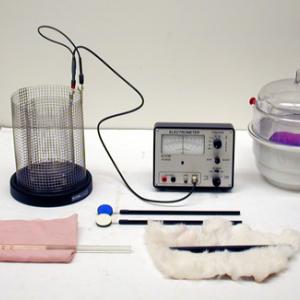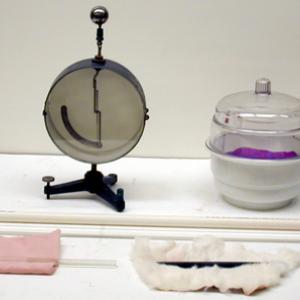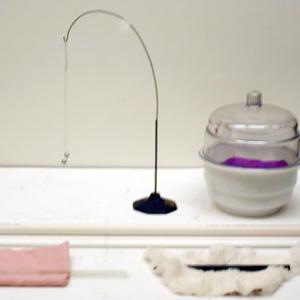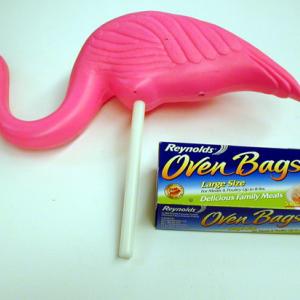College of Liberal Arts & Sciences
5A10.10 - Electrostatic Charges
During high humidity months the cats fur and silk cloth should be desiccated overnight.
The glass rod and silk will give a positive charge. The clear acrylic rod when rubbed with silk will also give a positive charge.
The ebonite and cats fur will be negatively charged as will the Lucite rod and latex. The PVC rod rubbed with cats fur will also give a negative charge. The Lucite rod will be charged only where the rod was rubbed.
Add some humor to the lecture. Instead of using the PVC rod and cats fur, try the pink flamingo and the oven bag as your charging pair. A Zigmund Peacock original.
- David Headly and Mohamed Karabatek, "Polarizing PVC - A Discrepant Event", TPT. Vol. 54, #1, Jan. 2016, p. 6.
- Martin Gardner, "Knock Off the Match", TPT, Vol. 38, #3, Mar. 2000, p. 191.
- Walter Roy Mellen, "Inexpensive Electrostatic Halos", TPT, Vol. 28, #9, Dec. 1990, p. 612.
- Wang Da-yuan, "Lightning Rod", TPT, Vol. 27, #9, Dec. 1989, p. 686.
- Clifford Bettis, "Do Physics Teachers Conserve Charge?", TPT, Vol. 27, #4, Apr. 1989, p. 271.
- Walter Roy Mellen, "Inexpensive Fun with Electrostatics", TPT, Vol. 27, #2, Feb. 1989, p. 86.
- Earl Zwicker and Bob Hetzel, "Response", TPT, Vol. 24, #8, Nov. 1986, p. 459.
- David S. Martin, "Second Look at Static Charge", TPT, Vol. 24, #8, Nov. 1986, p. 459.
- Robert Hetzel, Chris Chiaverina, and Scott Welty, "Sweater Charge", TPT, Vol. 24, #1, Jan. 1986, p. 55.
- Matt Young, "On the Vagueness of the Void", TPT, Vol. 18, #1, Jan. 1980, p. 10.
- Duane K. Fowler, "More on Unlike Charges", TPT, Vol. 17, #7, Oct. 1979, p. 416.
- Robert P. Barrett, "A Confession", TPT, Vol. 17, #6, Sept. 1979, p. 406.
- Herbert Gottlieb and Franklin Miler, Jr., "Why do Unlike Charges Attract Each Other?", TPT, Vol. 17, #3. Mar. 1979, p. 198.
- Robert P. Bauman, "Electrostatic Charges and Copying Machines", TPT Vol. 15, #9, Dec. 1977, p. 543, also A Potpourri of Physics Teaching Ideas - Electricity and Magnetism, p. 141.
- Robert P. Lanni, "Electrostatics Demonstrations", TPT, Vol. 7, #9, Dec. 1969, p. 513.
- W. R. Moreau, S. G. Ryan, S. J. Beuzenberg, and R. W. G. Syme, "Charge Density in Circuits", AJP, Vol. 53, #6, June 1985, p. 552.
- Jermey N. A. Matthews, "A Nanoscale Mosaic Model of Static Electricity", Physics Today, Vol. 64, #8, Aug. 2011, p. 18.
- E-015: "Plastic Tubes - Rods & Cloth", DICK and RAE Physics Demo Notebook.
- Ea-1, 15, 16, 17, 22, 23: Freier and Anderson, A Demonstration Handbook for Physics.
- Robert A. Morse, "Laboratory Activity 1: Separating Charges & Forces Between Charged Objects", Teaching about Electrostatics, p. 3 - 1.
- George M. Hopkins, "Frictional Electricity", Experimental Science, p. 361.
- Martin Gardner, "87, Knock Off the Match", Smart Science Tricks, p. 129.
- Martin Gardner, "The Invisible Leg", Entertaining Science Experiments with Everyday Objects, p. 90.
- Martin Gardner, "Un-Pepper the Salt", Entertaining Science Experiments with Everyday Objects, p. 89.
- Martin Gardner, "Static Electricity", Entertaining Science Experiments with Everyday Objects, p. 88.
- Vicki Cobb and Kathy Darling, "Out On a Limb", Bet You Can!, p. 57.
- Borislaw Bilash II, David Maiullo, "Charge It Up", A Demo a Day: A Year of Physics Demonstrations, p. 240.
- "Exploring Static Electricity", The Boy Scientist, p. 61.
- Janice VanCleave, "62, Defy Gravity", Teaching the Fun of Physics, p. 98.
- Jearl Walker, "5.9, Cars, Fuel Pumps, and Pit Stops", The Flying Circus of Physics Ed. 2, p. 222.
- 33, Stangl, "Static Electricity", Science Toolbox, p. 81.
- Shar Levine, Leslie Johnstone, "Chapter 20: Shake a Leg", Silly Science, p. 61.
- "Positive and Negative Charges", Physics From the Junk Drawer, 3rd Edition, The Science House, North Carolina State University, p. 29.
- Sara Stein, "Charges", The Science Book, p. 224.
- Curt Suplee, "Getting Charged", Everyday Science Explained, National Geographic, p. 86 - 87.
- W. Bolton, "Contact Potential", Book 4 - Electricity, Physics Experiments and Projects, 1968, p. 26.
- W. Bolton, "The Electric Charge on Falling Raindrops", Book 4 - Electricity, Physics Experiments and Projects, 1968, p. 108 - 109.
- Rudolf F. Graf, "Charge a Piece of Paper", Safe and Simple Electrical Experiments, p. 4.
- Rudolf F. Graf, "Building a Proof Plane", Safe and Simple Electrical Experiments, p. 20.
- Rudolf F. Graf, "Surprise the Cat", Safe and Simple Electrical Experiments, p. 34.
Disclaimer: These demonstrations are provided only for illustrative use by persons affiliated with The University of Iowa and only under the direction of a trained instructor or physicist. The University of Iowa is not responsible for demonstrations performed by those using their own equipment or who choose to use this reference material for their own purpose. The demonstrations included here are within the public domain and can be found in materials contained in libraries, bookstores, and through electronic sources. Performing all or any portion of any of these demonstrations, with or without revisions not depicted here entails inherent risks. These risks include, without limitation, bodily injury (and possibly death), including risks to health that may be temporary or permanent and that may exacerbate a pre-existing medical condition; and property loss or damage. Anyone performing any part of these demonstrations, even with revisions, knowingly and voluntarily assumes all risks associated with them.



